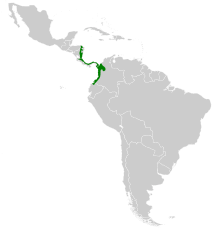Bronze-tailed plumeleteer
| Bronze-tailed plumeleteer | |
|---|---|
.jpg) | |
| Scientific classification | |
| Kingdom: | Animalia |
| Phylum: | Chordata |
| Class: | Aves |
| Order: | Apodiformes |
| Family: | Trochilidae |
| Genus: | Chalybura |
| Species: | C. urochrysia |
| Binomial name | |
| Chalybura urochrysia (Gould, 1861) | |
_taxobox.jpg)


The bronze-tailed plumeleteer (Chalybura urochrysia) is a large hummingbird resident in Central America and South America from eastern Honduras to northwestern Ecuador. The birds inhabit forests and have a preference for edges, gaps and secondary growth. It occurs in the Caribbean lowlands, typically up to an elevation of 700 metres.
The red-footed plumeleteer is the Costa Rican subspecies C. u. melanorrhoa and has a black, not bronze, tail.
The nest is a deep cup of plant fibres less than 1.5 metres high in a small shrub. The female alone incubates the two white eggs.
The bronze-tailed plumeleteer is 11 cm long and weighs 6 g (female) or 7 g (male). The male has bronze-green upperparts, glittering green underparts, a dusky lower belly and a bronzed or purple-black tail depending on subspecies. The female has bronze-green upperparts, grey underparts, including the lower belly, green speckling on the flanks and grey corners to the dusky bronze tail. Both sexes have pink or red feet. Young birds resemble the adult, but have buff feather tips to the head, neck and rump feathers.
The red-footed plumeleteer has a high metallic chip call, and the male’s song is a soft ter-pleeleeleelee ter-pleeleeleelee ter-pleeleeleelee ter-pleee.
This hummingbird is aggressive, territorial, and usually dominant. The male will defend large clumps of Heliconia and other large flowers.
References
- ↑ BirdLife International (2012). "Chalybura urochrysia". IUCN Red List of Threatened Species. Version 2013.2. International Union for Conservation of Nature. Retrieved 26 November 2013.
- Stiles and Skutch, A guide to the birds of Costa Rica ISBN 0-8014-9600-4
